Improving Student Retention Within UK Higher Education: A Case Study
VerifiedAdded on 2023/01/12
|37
|8694
|59
Report
AI Summary
This report investigates student retention within UK higher education, specifically focusing on a case study of the London School of Science and Technology. The research explores the concept of student retention, identifies challenges faced by institutions, and examines various strategies for improvement. The methodology includes a literature review, outlining challenges like cultural differences, financial constraints, and the need for innovation. The study employs a mixed-methods approach, including data analysis and discussion of findings. The report concludes with recommendations for the London School of Science and Technology to enhance student retention rates, addressing issues such as academic success, student support, and curriculum development. The findings provide insights into the factors influencing student decisions to remain enrolled and graduate. The study also highlights the significance of understanding student needs and providing appropriate support systems.
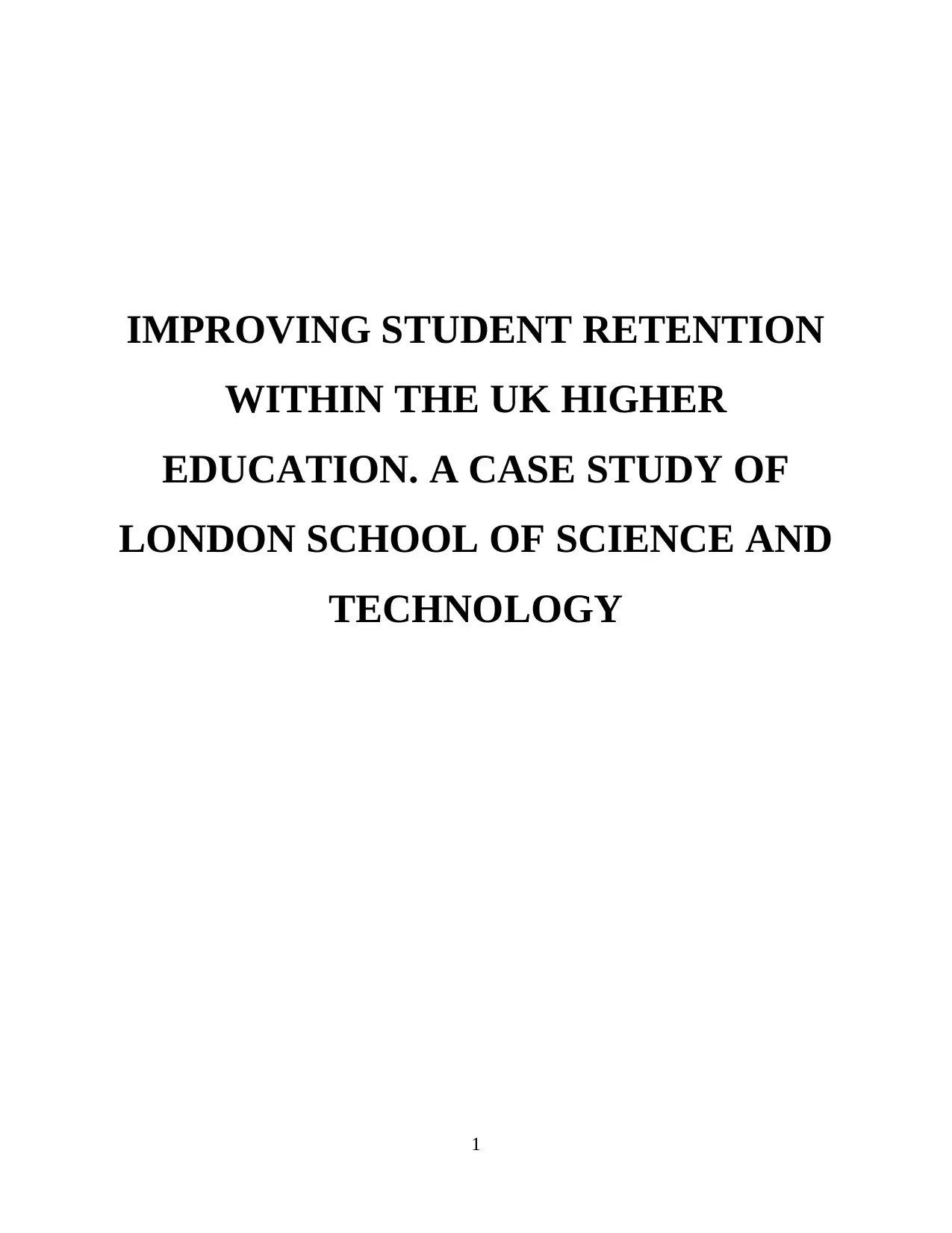
IMPROVING STUDENT RETENTION
WITHIN THE UK HIGHER
EDUCATION. A CASE STUDY OF
LONDON SCHOOL OF SCIENCE AND
TECHNOLOGY
1
WITHIN THE UK HIGHER
EDUCATION. A CASE STUDY OF
LONDON SCHOOL OF SCIENCE AND
TECHNOLOGY
1
Paraphrase This Document
Need a fresh take? Get an instant paraphrase of this document with our AI Paraphraser
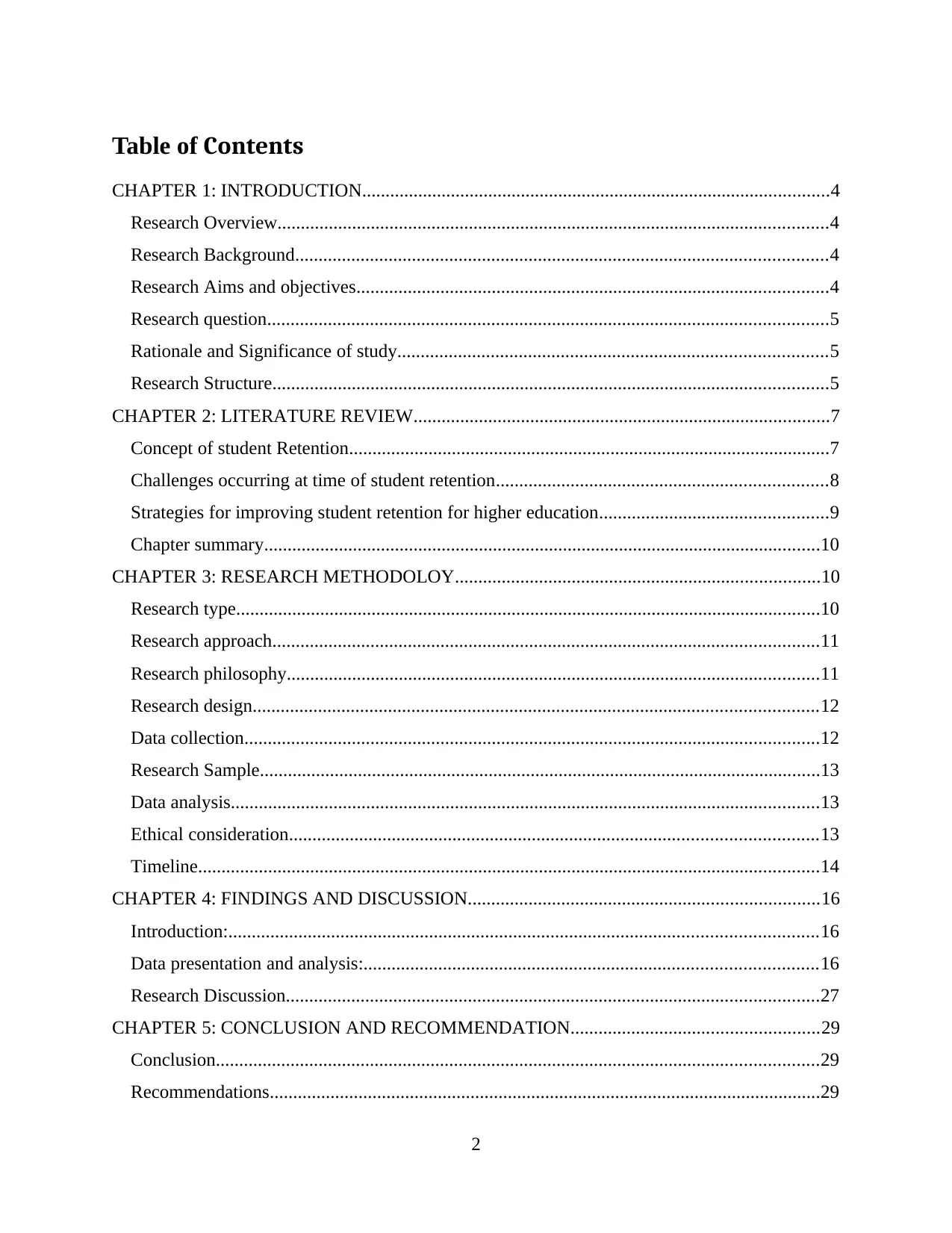
Table of Contents
CHAPTER 1: INTRODUCTION....................................................................................................4
Research Overview......................................................................................................................4
Research Background..................................................................................................................4
Research Aims and objectives.....................................................................................................4
Research question........................................................................................................................5
Rationale and Significance of study............................................................................................5
Research Structure.......................................................................................................................5
CHAPTER 2: LITERATURE REVIEW.........................................................................................7
Concept of student Retention.......................................................................................................7
Challenges occurring at time of student retention.......................................................................8
Strategies for improving student retention for higher education.................................................9
Chapter summary.......................................................................................................................10
CHAPTER 3: RESEARCH METHODOLOY..............................................................................10
Research type.............................................................................................................................10
Research approach.....................................................................................................................11
Research philosophy..................................................................................................................11
Research design.........................................................................................................................12
Data collection...........................................................................................................................12
Research Sample........................................................................................................................13
Data analysis..............................................................................................................................13
Ethical consideration.................................................................................................................13
Timeline.....................................................................................................................................14
CHAPTER 4: FINDINGS AND DISCUSSION...........................................................................16
Introduction:..............................................................................................................................16
Data presentation and analysis:.................................................................................................16
Research Discussion..................................................................................................................27
CHAPTER 5: CONCLUSION AND RECOMMENDATION.....................................................29
Conclusion.................................................................................................................................29
Recommendations......................................................................................................................29
2
CHAPTER 1: INTRODUCTION....................................................................................................4
Research Overview......................................................................................................................4
Research Background..................................................................................................................4
Research Aims and objectives.....................................................................................................4
Research question........................................................................................................................5
Rationale and Significance of study............................................................................................5
Research Structure.......................................................................................................................5
CHAPTER 2: LITERATURE REVIEW.........................................................................................7
Concept of student Retention.......................................................................................................7
Challenges occurring at time of student retention.......................................................................8
Strategies for improving student retention for higher education.................................................9
Chapter summary.......................................................................................................................10
CHAPTER 3: RESEARCH METHODOLOY..............................................................................10
Research type.............................................................................................................................10
Research approach.....................................................................................................................11
Research philosophy..................................................................................................................11
Research design.........................................................................................................................12
Data collection...........................................................................................................................12
Research Sample........................................................................................................................13
Data analysis..............................................................................................................................13
Ethical consideration.................................................................................................................13
Timeline.....................................................................................................................................14
CHAPTER 4: FINDINGS AND DISCUSSION...........................................................................16
Introduction:..............................................................................................................................16
Data presentation and analysis:.................................................................................................16
Research Discussion..................................................................................................................27
CHAPTER 5: CONCLUSION AND RECOMMENDATION.....................................................29
Conclusion.................................................................................................................................29
Recommendations......................................................................................................................29
2
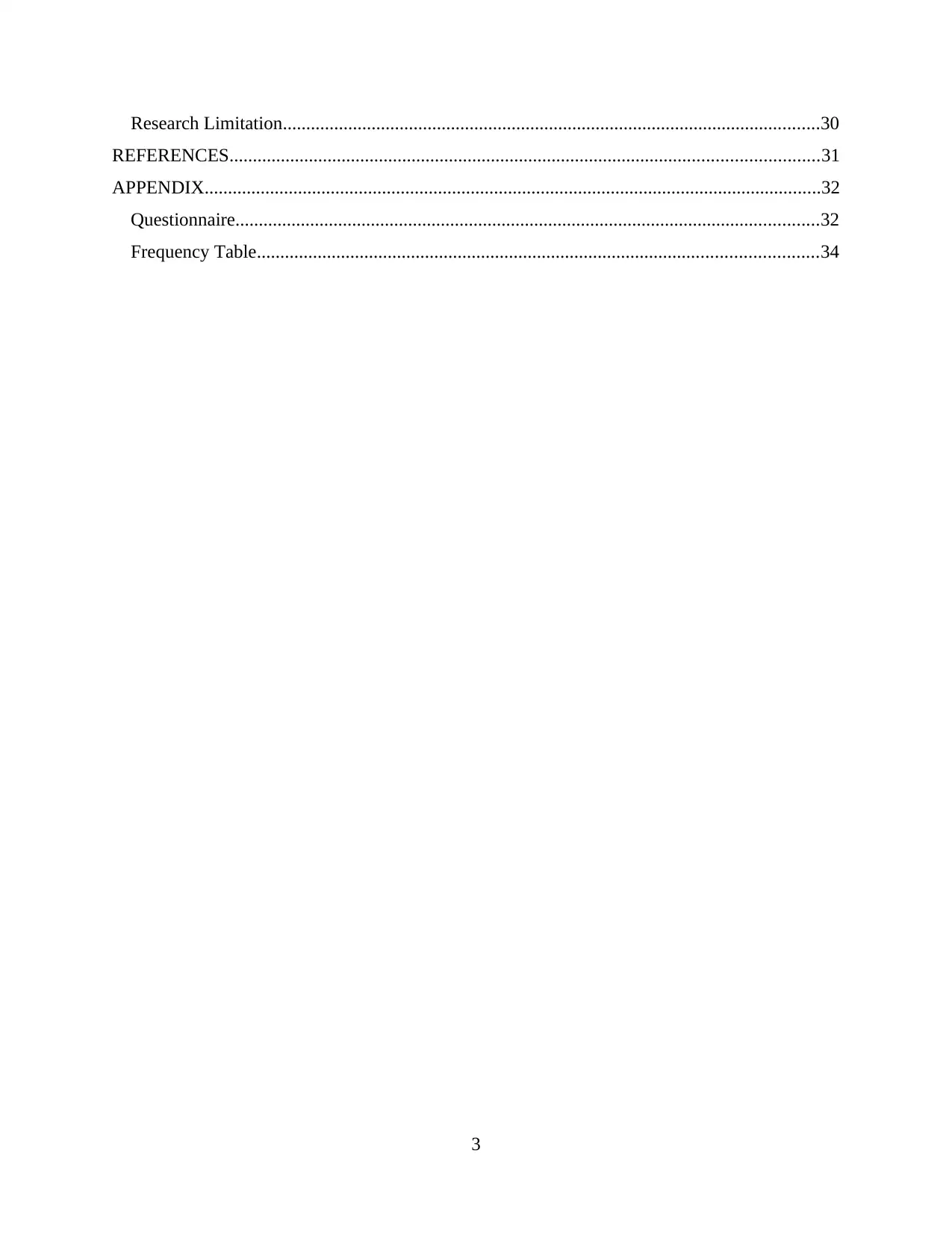
Research Limitation...................................................................................................................30
REFERENCES..............................................................................................................................31
APPENDIX....................................................................................................................................32
Questionnaire.............................................................................................................................32
Frequency Table........................................................................................................................34
3
REFERENCES..............................................................................................................................31
APPENDIX....................................................................................................................................32
Questionnaire.............................................................................................................................32
Frequency Table........................................................................................................................34
3
⊘ This is a preview!⊘
Do you want full access?
Subscribe today to unlock all pages.

Trusted by 1+ million students worldwide
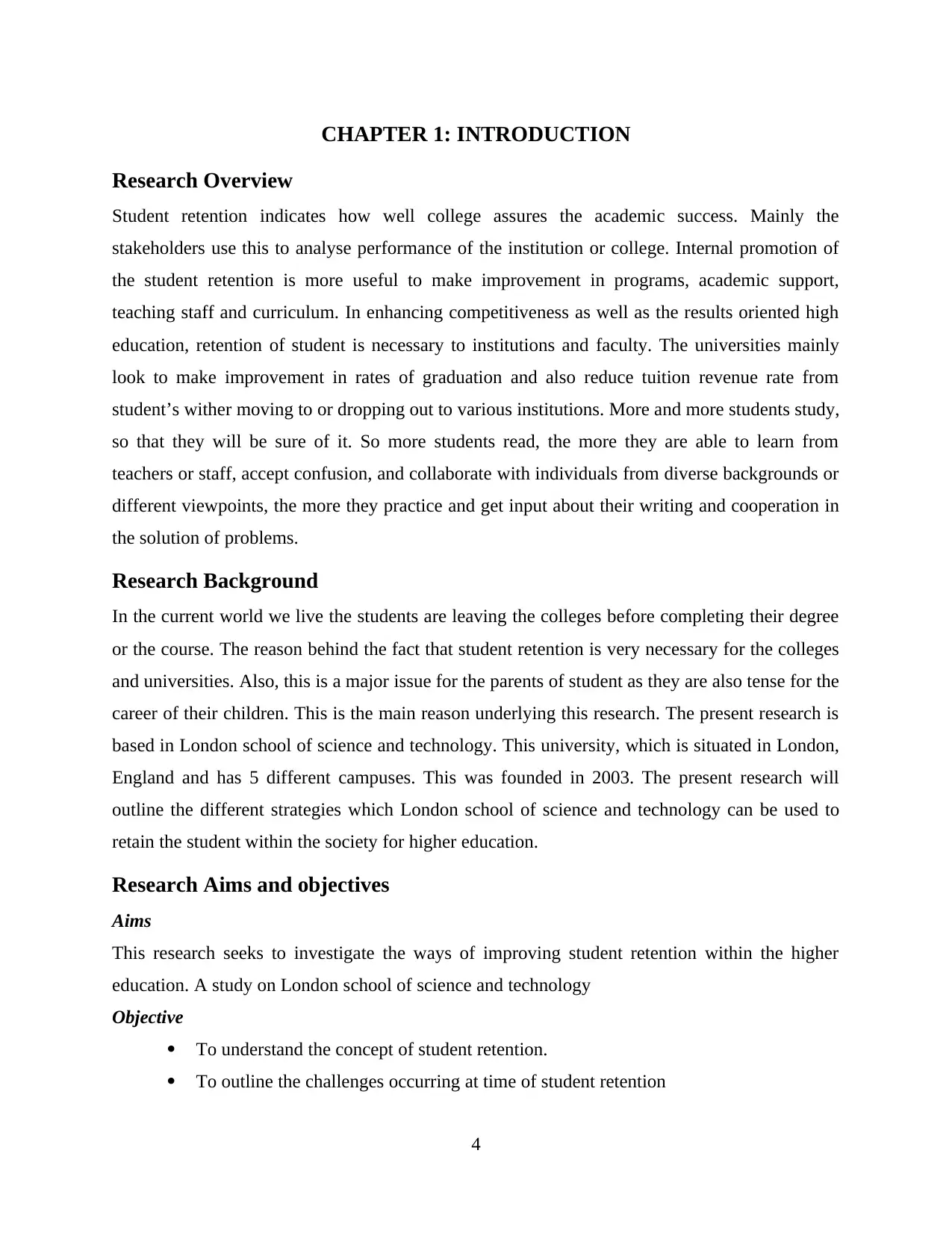
CHAPTER 1: INTRODUCTION
Research Overview
Student retention indicates how well college assures the academic success. Mainly the
stakeholders use this to analyse performance of the institution or college. Internal promotion of
the student retention is more useful to make improvement in programs, academic support,
teaching staff and curriculum. In enhancing competitiveness as well as the results oriented high
education, retention of student is necessary to institutions and faculty. The universities mainly
look to make improvement in rates of graduation and also reduce tuition revenue rate from
student’s wither moving to or dropping out to various institutions. More and more students study,
so that they will be sure of it. So more students read, the more they are able to learn from
teachers or staff, accept confusion, and collaborate with individuals from diverse backgrounds or
different viewpoints, the more they practice and get input about their writing and cooperation in
the solution of problems.
Research Background
In the current world we live the students are leaving the colleges before completing their degree
or the course. The reason behind the fact that student retention is very necessary for the colleges
and universities. Also, this is a major issue for the parents of student as they are also tense for the
career of their children. This is the main reason underlying this research. The present research is
based in London school of science and technology. This university, which is situated in London,
England and has 5 different campuses. This was founded in 2003. The present research will
outline the different strategies which London school of science and technology can be used to
retain the student within the society for higher education.
Research Aims and objectives
Aims
This research seeks to investigate the ways of improving student retention within the higher
education. A study on London school of science and technology
Objective
To understand the concept of student retention.
To outline the challenges occurring at time of student retention
4
Research Overview
Student retention indicates how well college assures the academic success. Mainly the
stakeholders use this to analyse performance of the institution or college. Internal promotion of
the student retention is more useful to make improvement in programs, academic support,
teaching staff and curriculum. In enhancing competitiveness as well as the results oriented high
education, retention of student is necessary to institutions and faculty. The universities mainly
look to make improvement in rates of graduation and also reduce tuition revenue rate from
student’s wither moving to or dropping out to various institutions. More and more students study,
so that they will be sure of it. So more students read, the more they are able to learn from
teachers or staff, accept confusion, and collaborate with individuals from diverse backgrounds or
different viewpoints, the more they practice and get input about their writing and cooperation in
the solution of problems.
Research Background
In the current world we live the students are leaving the colleges before completing their degree
or the course. The reason behind the fact that student retention is very necessary for the colleges
and universities. Also, this is a major issue for the parents of student as they are also tense for the
career of their children. This is the main reason underlying this research. The present research is
based in London school of science and technology. This university, which is situated in London,
England and has 5 different campuses. This was founded in 2003. The present research will
outline the different strategies which London school of science and technology can be used to
retain the student within the society for higher education.
Research Aims and objectives
Aims
This research seeks to investigate the ways of improving student retention within the higher
education. A study on London school of science and technology
Objective
To understand the concept of student retention.
To outline the challenges occurring at time of student retention
4
Paraphrase This Document
Need a fresh take? Get an instant paraphrase of this document with our AI Paraphraser
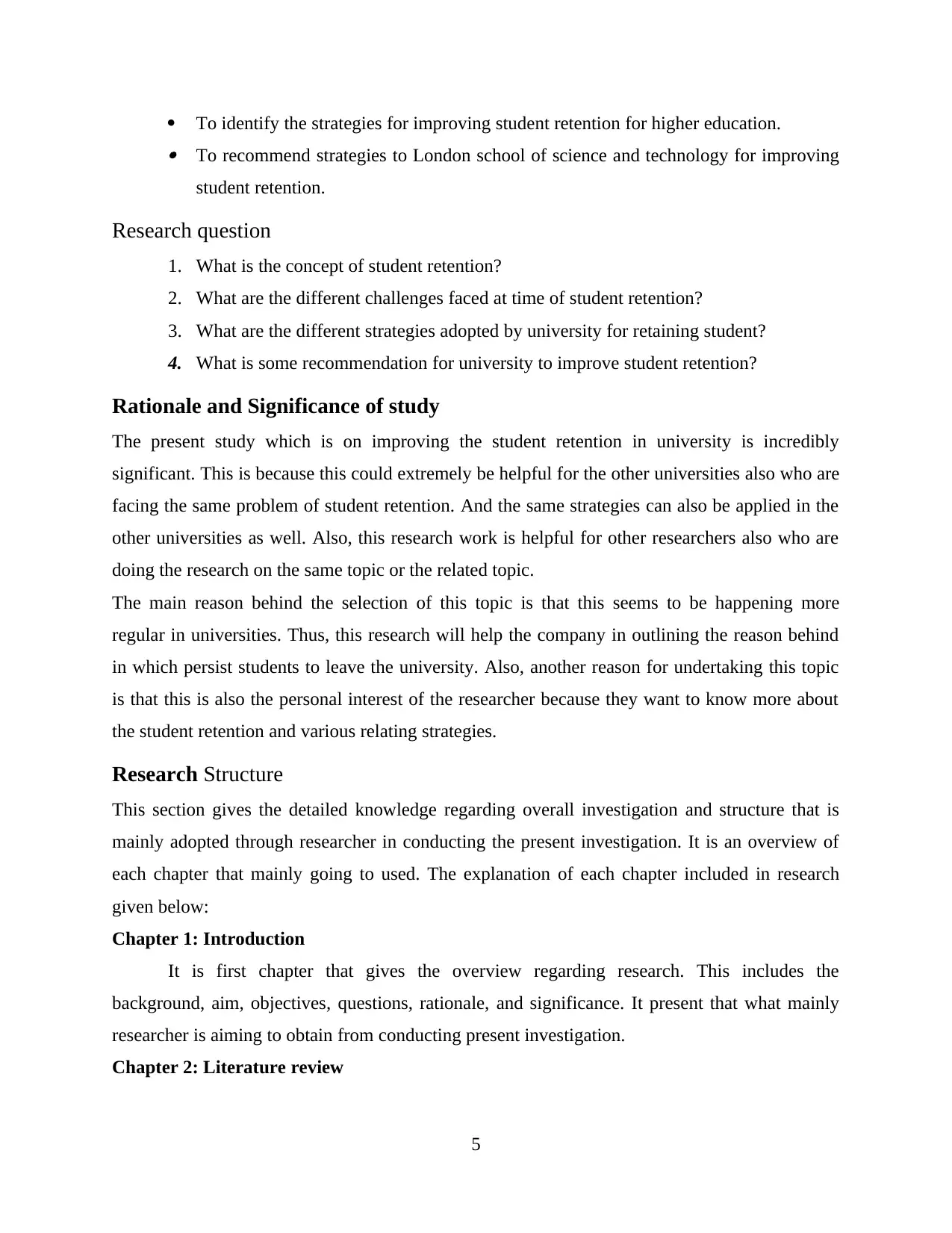
To identify the strategies for improving student retention for higher education.
To recommend strategies to London school of science and technology for improving
student retention.
Research question
1. What is the concept of student retention?
2. What are the different challenges faced at time of student retention?
3. What are the different strategies adopted by university for retaining student?
4. What is some recommendation for university to improve student retention?
Rationale and Significance of study
The present study which is on improving the student retention in university is incredibly
significant. This is because this could extremely be helpful for the other universities also who are
facing the same problem of student retention. And the same strategies can also be applied in the
other universities as well. Also, this research work is helpful for other researchers also who are
doing the research on the same topic or the related topic.
The main reason behind the selection of this topic is that this seems to be happening more
regular in universities. Thus, this research will help the company in outlining the reason behind
in which persist students to leave the university. Also, another reason for undertaking this topic
is that this is also the personal interest of the researcher because they want to know more about
the student retention and various relating strategies.
Research Structure
This section gives the detailed knowledge regarding overall investigation and structure that is
mainly adopted through researcher in conducting the present investigation. It is an overview of
each chapter that mainly going to used. The explanation of each chapter included in research
given below:
Chapter 1: Introduction
It is first chapter that gives the overview regarding research. This includes the
background, aim, objectives, questions, rationale, and significance. It present that what mainly
researcher is aiming to obtain from conducting present investigation.
Chapter 2: Literature review
5
To recommend strategies to London school of science and technology for improving
student retention.
Research question
1. What is the concept of student retention?
2. What are the different challenges faced at time of student retention?
3. What are the different strategies adopted by university for retaining student?
4. What is some recommendation for university to improve student retention?
Rationale and Significance of study
The present study which is on improving the student retention in university is incredibly
significant. This is because this could extremely be helpful for the other universities also who are
facing the same problem of student retention. And the same strategies can also be applied in the
other universities as well. Also, this research work is helpful for other researchers also who are
doing the research on the same topic or the related topic.
The main reason behind the selection of this topic is that this seems to be happening more
regular in universities. Thus, this research will help the company in outlining the reason behind
in which persist students to leave the university. Also, another reason for undertaking this topic
is that this is also the personal interest of the researcher because they want to know more about
the student retention and various relating strategies.
Research Structure
This section gives the detailed knowledge regarding overall investigation and structure that is
mainly adopted through researcher in conducting the present investigation. It is an overview of
each chapter that mainly going to used. The explanation of each chapter included in research
given below:
Chapter 1: Introduction
It is first chapter that gives the overview regarding research. This includes the
background, aim, objectives, questions, rationale, and significance. It present that what mainly
researcher is aiming to obtain from conducting present investigation.
Chapter 2: Literature review
5
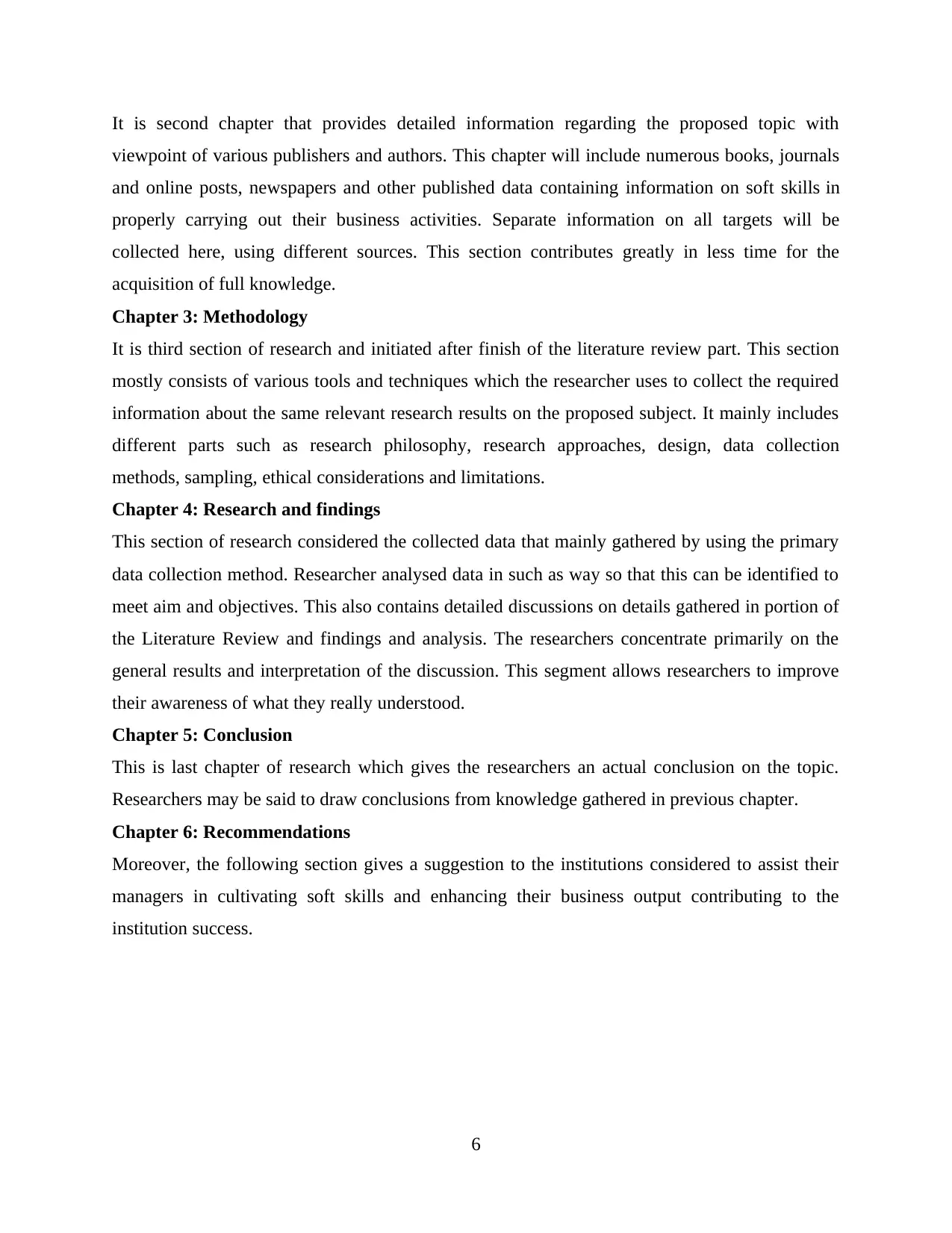
It is second chapter that provides detailed information regarding the proposed topic with
viewpoint of various publishers and authors. This chapter will include numerous books, journals
and online posts, newspapers and other published data containing information on soft skills in
properly carrying out their business activities. Separate information on all targets will be
collected here, using different sources. This section contributes greatly in less time for the
acquisition of full knowledge.
Chapter 3: Methodology
It is third section of research and initiated after finish of the literature review part. This section
mostly consists of various tools and techniques which the researcher uses to collect the required
information about the same relevant research results on the proposed subject. It mainly includes
different parts such as research philosophy, research approaches, design, data collection
methods, sampling, ethical considerations and limitations.
Chapter 4: Research and findings
This section of research considered the collected data that mainly gathered by using the primary
data collection method. Researcher analysed data in such as way so that this can be identified to
meet aim and objectives. This also contains detailed discussions on details gathered in portion of
the Literature Review and findings and analysis. The researchers concentrate primarily on the
general results and interpretation of the discussion. This segment allows researchers to improve
their awareness of what they really understood.
Chapter 5: Conclusion
This is last chapter of research which gives the researchers an actual conclusion on the topic.
Researchers may be said to draw conclusions from knowledge gathered in previous chapter.
Chapter 6: Recommendations
Moreover, the following section gives a suggestion to the institutions considered to assist their
managers in cultivating soft skills and enhancing their business output contributing to the
institution success.
6
viewpoint of various publishers and authors. This chapter will include numerous books, journals
and online posts, newspapers and other published data containing information on soft skills in
properly carrying out their business activities. Separate information on all targets will be
collected here, using different sources. This section contributes greatly in less time for the
acquisition of full knowledge.
Chapter 3: Methodology
It is third section of research and initiated after finish of the literature review part. This section
mostly consists of various tools and techniques which the researcher uses to collect the required
information about the same relevant research results on the proposed subject. It mainly includes
different parts such as research philosophy, research approaches, design, data collection
methods, sampling, ethical considerations and limitations.
Chapter 4: Research and findings
This section of research considered the collected data that mainly gathered by using the primary
data collection method. Researcher analysed data in such as way so that this can be identified to
meet aim and objectives. This also contains detailed discussions on details gathered in portion of
the Literature Review and findings and analysis. The researchers concentrate primarily on the
general results and interpretation of the discussion. This segment allows researchers to improve
their awareness of what they really understood.
Chapter 5: Conclusion
This is last chapter of research which gives the researchers an actual conclusion on the topic.
Researchers may be said to draw conclusions from knowledge gathered in previous chapter.
Chapter 6: Recommendations
Moreover, the following section gives a suggestion to the institutions considered to assist their
managers in cultivating soft skills and enhancing their business output contributing to the
institution success.
6
⊘ This is a preview!⊘
Do you want full access?
Subscribe today to unlock all pages.

Trusted by 1+ million students worldwide
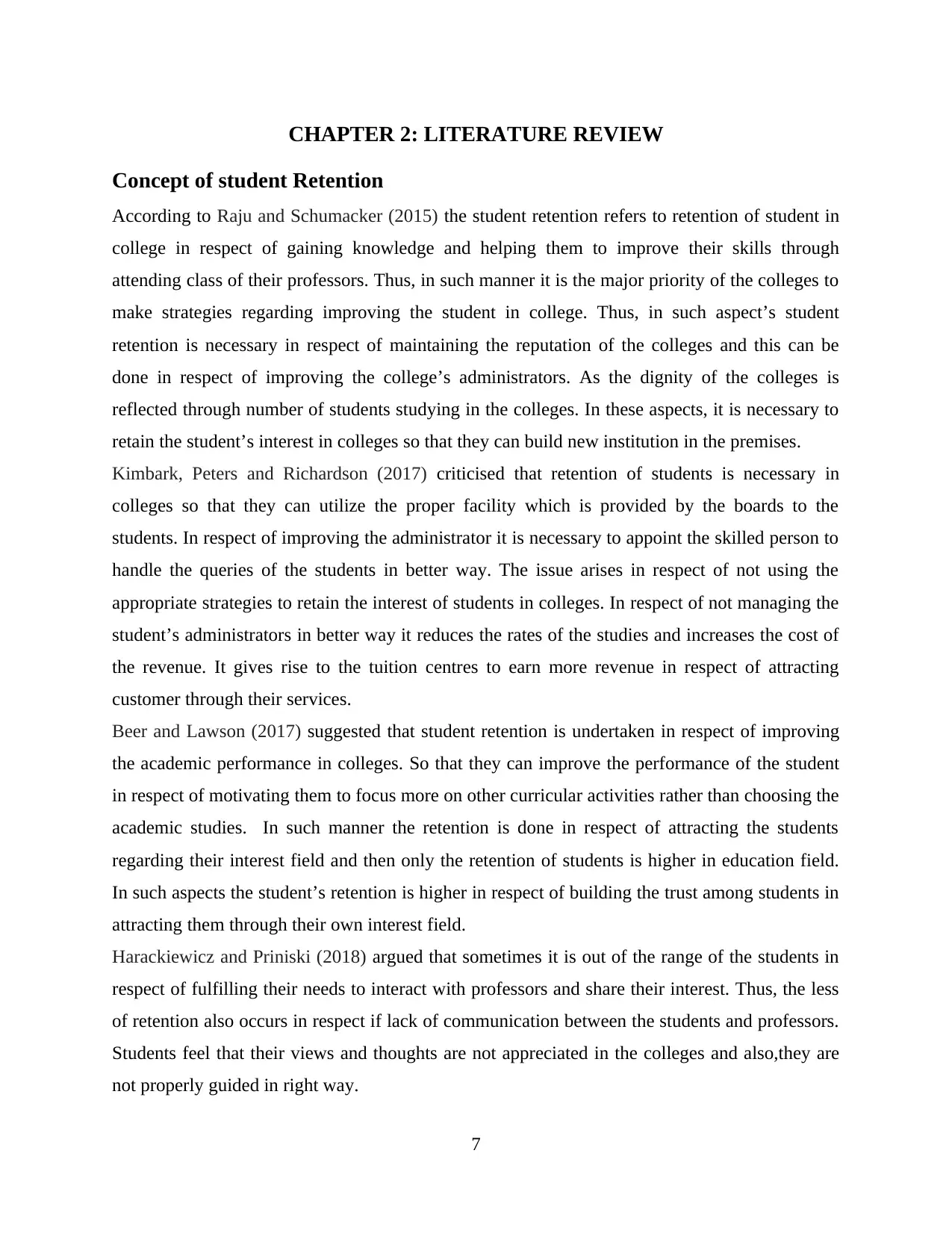
CHAPTER 2: LITERATURE REVIEW
Concept of student Retention
According to Raju and Schumacker (2015) the student retention refers to retention of student in
college in respect of gaining knowledge and helping them to improve their skills through
attending class of their professors. Thus, in such manner it is the major priority of the colleges to
make strategies regarding improving the student in college. Thus, in such aspect’s student
retention is necessary in respect of maintaining the reputation of the colleges and this can be
done in respect of improving the college’s administrators. As the dignity of the colleges is
reflected through number of students studying in the colleges. In these aspects, it is necessary to
retain the student’s interest in colleges so that they can build new institution in the premises.
Kimbark, Peters and Richardson (2017) criticised that retention of students is necessary in
colleges so that they can utilize the proper facility which is provided by the boards to the
students. In respect of improving the administrator it is necessary to appoint the skilled person to
handle the queries of the students in better way. The issue arises in respect of not using the
appropriate strategies to retain the interest of students in colleges. In respect of not managing the
student’s administrators in better way it reduces the rates of the studies and increases the cost of
the revenue. It gives rise to the tuition centres to earn more revenue in respect of attracting
customer through their services.
Beer and Lawson (2017) suggested that student retention is undertaken in respect of improving
the academic performance in colleges. So that they can improve the performance of the student
in respect of motivating them to focus more on other curricular activities rather than choosing the
academic studies. In such manner the retention is done in respect of attracting the students
regarding their interest field and then only the retention of students is higher in education field.
In such aspects the student’s retention is higher in respect of building the trust among students in
attracting them through their own interest field.
Harackiewicz and Priniski (2018) argued that sometimes it is out of the range of the students in
respect of fulfilling their needs to interact with professors and share their interest. Thus, the less
of retention also occurs in respect if lack of communication between the students and professors.
Students feel that their views and thoughts are not appreciated in the colleges and also,they are
not properly guided in right way.
7
Concept of student Retention
According to Raju and Schumacker (2015) the student retention refers to retention of student in
college in respect of gaining knowledge and helping them to improve their skills through
attending class of their professors. Thus, in such manner it is the major priority of the colleges to
make strategies regarding improving the student in college. Thus, in such aspect’s student
retention is necessary in respect of maintaining the reputation of the colleges and this can be
done in respect of improving the college’s administrators. As the dignity of the colleges is
reflected through number of students studying in the colleges. In these aspects, it is necessary to
retain the student’s interest in colleges so that they can build new institution in the premises.
Kimbark, Peters and Richardson (2017) criticised that retention of students is necessary in
colleges so that they can utilize the proper facility which is provided by the boards to the
students. In respect of improving the administrator it is necessary to appoint the skilled person to
handle the queries of the students in better way. The issue arises in respect of not using the
appropriate strategies to retain the interest of students in colleges. In respect of not managing the
student’s administrators in better way it reduces the rates of the studies and increases the cost of
the revenue. It gives rise to the tuition centres to earn more revenue in respect of attracting
customer through their services.
Beer and Lawson (2017) suggested that student retention is undertaken in respect of improving
the academic performance in colleges. So that they can improve the performance of the student
in respect of motivating them to focus more on other curricular activities rather than choosing the
academic studies. In such manner the retention is done in respect of attracting the students
regarding their interest field and then only the retention of students is higher in education field.
In such aspects the student’s retention is higher in respect of building the trust among students in
attracting them through their own interest field.
Harackiewicz and Priniski (2018) argued that sometimes it is out of the range of the students in
respect of fulfilling their needs to interact with professors and share their interest. Thus, the less
of retention also occurs in respect if lack of communication between the students and professors.
Students feel that their views and thoughts are not appreciated in the colleges and also,they are
not properly guided in right way.
7
Paraphrase This Document
Need a fresh take? Get an instant paraphrase of this document with our AI Paraphraser
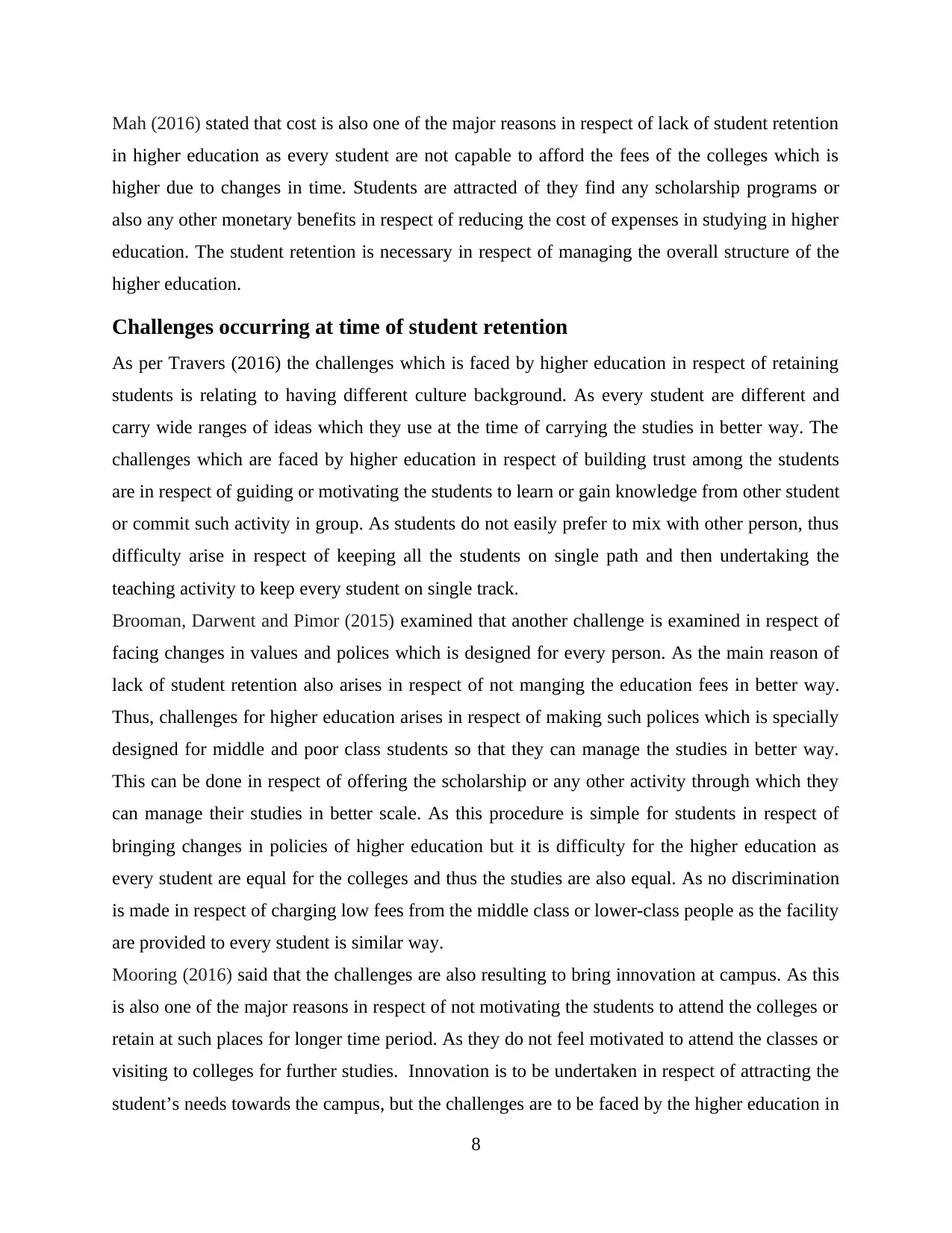
Mah (2016) stated that cost is also one of the major reasons in respect of lack of student retention
in higher education as every student are not capable to afford the fees of the colleges which is
higher due to changes in time. Students are attracted of they find any scholarship programs or
also any other monetary benefits in respect of reducing the cost of expenses in studying in higher
education. The student retention is necessary in respect of managing the overall structure of the
higher education.
Challenges occurring at time of student retention
As per Travers (2016) the challenges which is faced by higher education in respect of retaining
students is relating to having different culture background. As every student are different and
carry wide ranges of ideas which they use at the time of carrying the studies in better way. The
challenges which are faced by higher education in respect of building trust among the students
are in respect of guiding or motivating the students to learn or gain knowledge from other student
or commit such activity in group. As students do not easily prefer to mix with other person, thus
difficulty arise in respect of keeping all the students on single path and then undertaking the
teaching activity to keep every student on single track.
Brooman, Darwent and Pimor (2015) examined that another challenge is examined in respect of
facing changes in values and polices which is designed for every person. As the main reason of
lack of student retention also arises in respect of not manging the education fees in better way.
Thus, challenges for higher education arises in respect of making such polices which is specially
designed for middle and poor class students so that they can manage the studies in better way.
This can be done in respect of offering the scholarship or any other activity through which they
can manage their studies in better scale. As this procedure is simple for students in respect of
bringing changes in policies of higher education but it is difficulty for the higher education as
every student are equal for the colleges and thus the studies are also equal. As no discrimination
is made in respect of charging low fees from the middle class or lower-class people as the facility
are provided to every student is similar way.
Mooring (2016) said that the challenges are also resulting to bring innovation at campus. As this
is also one of the major reasons in respect of not motivating the students to attend the colleges or
retain at such places for longer time period. As they do not feel motivated to attend the classes or
visiting to colleges for further studies. Innovation is to be undertaken in respect of attracting the
student’s needs towards the campus, but the challenges are to be faced by the higher education in
8
in higher education as every student are not capable to afford the fees of the colleges which is
higher due to changes in time. Students are attracted of they find any scholarship programs or
also any other monetary benefits in respect of reducing the cost of expenses in studying in higher
education. The student retention is necessary in respect of managing the overall structure of the
higher education.
Challenges occurring at time of student retention
As per Travers (2016) the challenges which is faced by higher education in respect of retaining
students is relating to having different culture background. As every student are different and
carry wide ranges of ideas which they use at the time of carrying the studies in better way. The
challenges which are faced by higher education in respect of building trust among the students
are in respect of guiding or motivating the students to learn or gain knowledge from other student
or commit such activity in group. As students do not easily prefer to mix with other person, thus
difficulty arise in respect of keeping all the students on single path and then undertaking the
teaching activity to keep every student on single track.
Brooman, Darwent and Pimor (2015) examined that another challenge is examined in respect of
facing changes in values and polices which is designed for every person. As the main reason of
lack of student retention also arises in respect of not manging the education fees in better way.
Thus, challenges for higher education arises in respect of making such polices which is specially
designed for middle and poor class students so that they can manage the studies in better way.
This can be done in respect of offering the scholarship or any other activity through which they
can manage their studies in better scale. As this procedure is simple for students in respect of
bringing changes in policies of higher education but it is difficulty for the higher education as
every student are equal for the colleges and thus the studies are also equal. As no discrimination
is made in respect of charging low fees from the middle class or lower-class people as the facility
are provided to every student is similar way.
Mooring (2016) said that the challenges are also resulting to bring innovation at campus. As this
is also one of the major reasons in respect of not motivating the students to attend the colleges or
retain at such places for longer time period. As they do not feel motivated to attend the classes or
visiting to colleges for further studies. Innovation is to be undertaken in respect of attracting the
student’s needs towards the campus, but the challenges are to be faced by the higher education in
8
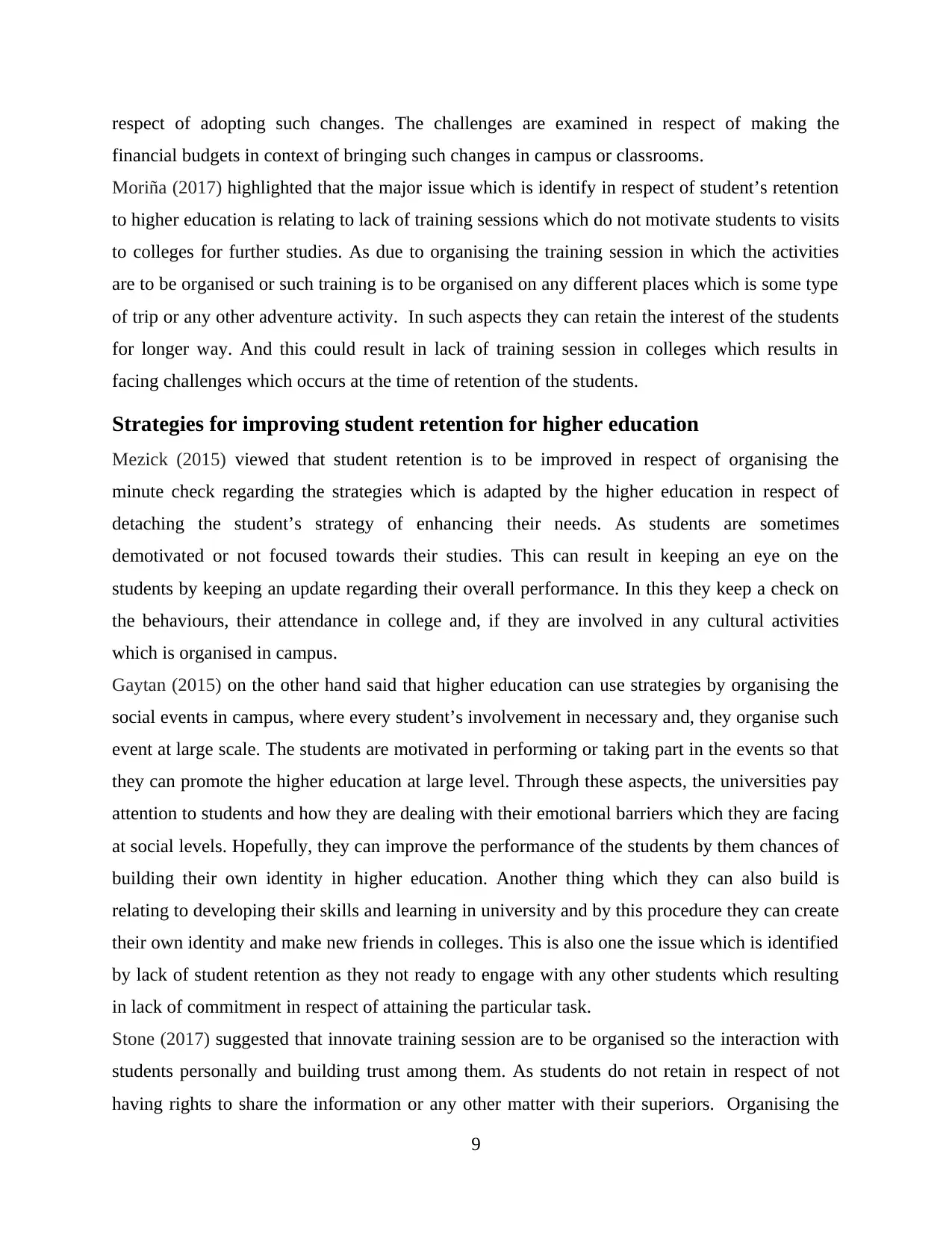
respect of adopting such changes. The challenges are examined in respect of making the
financial budgets in context of bringing such changes in campus or classrooms.
Moriña (2017) highlighted that the major issue which is identify in respect of student’s retention
to higher education is relating to lack of training sessions which do not motivate students to visits
to colleges for further studies. As due to organising the training session in which the activities
are to be organised or such training is to be organised on any different places which is some type
of trip or any other adventure activity. In such aspects they can retain the interest of the students
for longer way. And this could result in lack of training session in colleges which results in
facing challenges which occurs at the time of retention of the students.
Strategies for improving student retention for higher education
Mezick (2015) viewed that student retention is to be improved in respect of organising the
minute check regarding the strategies which is adapted by the higher education in respect of
detaching the student’s strategy of enhancing their needs. As students are sometimes
demotivated or not focused towards their studies. This can result in keeping an eye on the
students by keeping an update regarding their overall performance. In this they keep a check on
the behaviours, their attendance in college and, if they are involved in any cultural activities
which is organised in campus.
Gaytan (2015) on the other hand said that higher education can use strategies by organising the
social events in campus, where every student’s involvement in necessary and, they organise such
event at large scale. The students are motivated in performing or taking part in the events so that
they can promote the higher education at large level. Through these aspects, the universities pay
attention to students and how they are dealing with their emotional barriers which they are facing
at social levels. Hopefully, they can improve the performance of the students by them chances of
building their own identity in higher education. Another thing which they can also build is
relating to developing their skills and learning in university and by this procedure they can create
their own identity and make new friends in colleges. This is also one the issue which is identified
by lack of student retention as they not ready to engage with any other students which resulting
in lack of commitment in respect of attaining the particular task.
Stone (2017) suggested that innovate training session are to be organised so the interaction with
students personally and building trust among them. As students do not retain in respect of not
having rights to share the information or any other matter with their superiors. Organising the
9
financial budgets in context of bringing such changes in campus or classrooms.
Moriña (2017) highlighted that the major issue which is identify in respect of student’s retention
to higher education is relating to lack of training sessions which do not motivate students to visits
to colleges for further studies. As due to organising the training session in which the activities
are to be organised or such training is to be organised on any different places which is some type
of trip or any other adventure activity. In such aspects they can retain the interest of the students
for longer way. And this could result in lack of training session in colleges which results in
facing challenges which occurs at the time of retention of the students.
Strategies for improving student retention for higher education
Mezick (2015) viewed that student retention is to be improved in respect of organising the
minute check regarding the strategies which is adapted by the higher education in respect of
detaching the student’s strategy of enhancing their needs. As students are sometimes
demotivated or not focused towards their studies. This can result in keeping an eye on the
students by keeping an update regarding their overall performance. In this they keep a check on
the behaviours, their attendance in college and, if they are involved in any cultural activities
which is organised in campus.
Gaytan (2015) on the other hand said that higher education can use strategies by organising the
social events in campus, where every student’s involvement in necessary and, they organise such
event at large scale. The students are motivated in performing or taking part in the events so that
they can promote the higher education at large level. Through these aspects, the universities pay
attention to students and how they are dealing with their emotional barriers which they are facing
at social levels. Hopefully, they can improve the performance of the students by them chances of
building their own identity in higher education. Another thing which they can also build is
relating to developing their skills and learning in university and by this procedure they can create
their own identity and make new friends in colleges. This is also one the issue which is identified
by lack of student retention as they not ready to engage with any other students which resulting
in lack of commitment in respect of attaining the particular task.
Stone (2017) suggested that innovate training session are to be organised so the interaction with
students personally and building trust among them. As students do not retain in respect of not
having rights to share the information or any other matter with their superiors. Organising the
9
⊘ This is a preview!⊘
Do you want full access?
Subscribe today to unlock all pages.

Trusted by 1+ million students worldwide
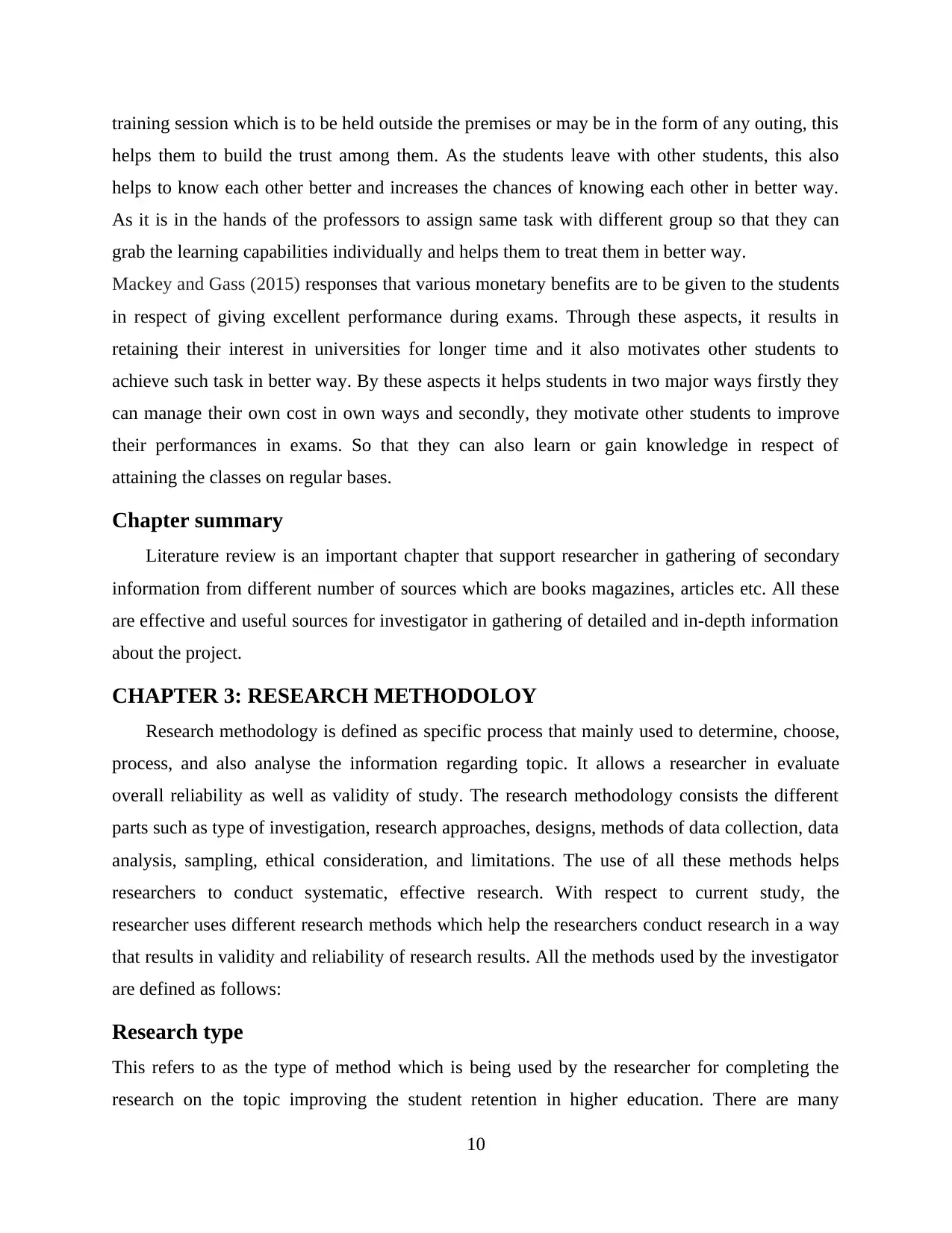
training session which is to be held outside the premises or may be in the form of any outing, this
helps them to build the trust among them. As the students leave with other students, this also
helps to know each other better and increases the chances of knowing each other in better way.
As it is in the hands of the professors to assign same task with different group so that they can
grab the learning capabilities individually and helps them to treat them in better way.
Mackey and Gass (2015) responses that various monetary benefits are to be given to the students
in respect of giving excellent performance during exams. Through these aspects, it results in
retaining their interest in universities for longer time and it also motivates other students to
achieve such task in better way. By these aspects it helps students in two major ways firstly they
can manage their own cost in own ways and secondly, they motivate other students to improve
their performances in exams. So that they can also learn or gain knowledge in respect of
attaining the classes on regular bases.
Chapter summary
Literature review is an important chapter that support researcher in gathering of secondary
information from different number of sources which are books magazines, articles etc. All these
are effective and useful sources for investigator in gathering of detailed and in-depth information
about the project.
CHAPTER 3: RESEARCH METHODOLOY
Research methodology is defined as specific process that mainly used to determine, choose,
process, and also analyse the information regarding topic. It allows a researcher in evaluate
overall reliability as well as validity of study. The research methodology consists the different
parts such as type of investigation, research approaches, designs, methods of data collection, data
analysis, sampling, ethical consideration, and limitations. The use of all these methods helps
researchers to conduct systematic, effective research. With respect to current study, the
researcher uses different research methods which help the researchers conduct research in a way
that results in validity and reliability of research results. All the methods used by the investigator
are defined as follows:
Research type
This refers to as the type of method which is being used by the researcher for completing the
research on the topic improving the student retention in higher education. There are many
10
helps them to build the trust among them. As the students leave with other students, this also
helps to know each other better and increases the chances of knowing each other in better way.
As it is in the hands of the professors to assign same task with different group so that they can
grab the learning capabilities individually and helps them to treat them in better way.
Mackey and Gass (2015) responses that various monetary benefits are to be given to the students
in respect of giving excellent performance during exams. Through these aspects, it results in
retaining their interest in universities for longer time and it also motivates other students to
achieve such task in better way. By these aspects it helps students in two major ways firstly they
can manage their own cost in own ways and secondly, they motivate other students to improve
their performances in exams. So that they can also learn or gain knowledge in respect of
attaining the classes on regular bases.
Chapter summary
Literature review is an important chapter that support researcher in gathering of secondary
information from different number of sources which are books magazines, articles etc. All these
are effective and useful sources for investigator in gathering of detailed and in-depth information
about the project.
CHAPTER 3: RESEARCH METHODOLOY
Research methodology is defined as specific process that mainly used to determine, choose,
process, and also analyse the information regarding topic. It allows a researcher in evaluate
overall reliability as well as validity of study. The research methodology consists the different
parts such as type of investigation, research approaches, designs, methods of data collection, data
analysis, sampling, ethical consideration, and limitations. The use of all these methods helps
researchers to conduct systematic, effective research. With respect to current study, the
researcher uses different research methods which help the researchers conduct research in a way
that results in validity and reliability of research results. All the methods used by the investigator
are defined as follows:
Research type
This refers to as the type of method which is being used by the researcher for completing the
research on the topic improving the student retention in higher education. There are many
10
Paraphrase This Document
Need a fresh take? Get an instant paraphrase of this document with our AI Paraphraser
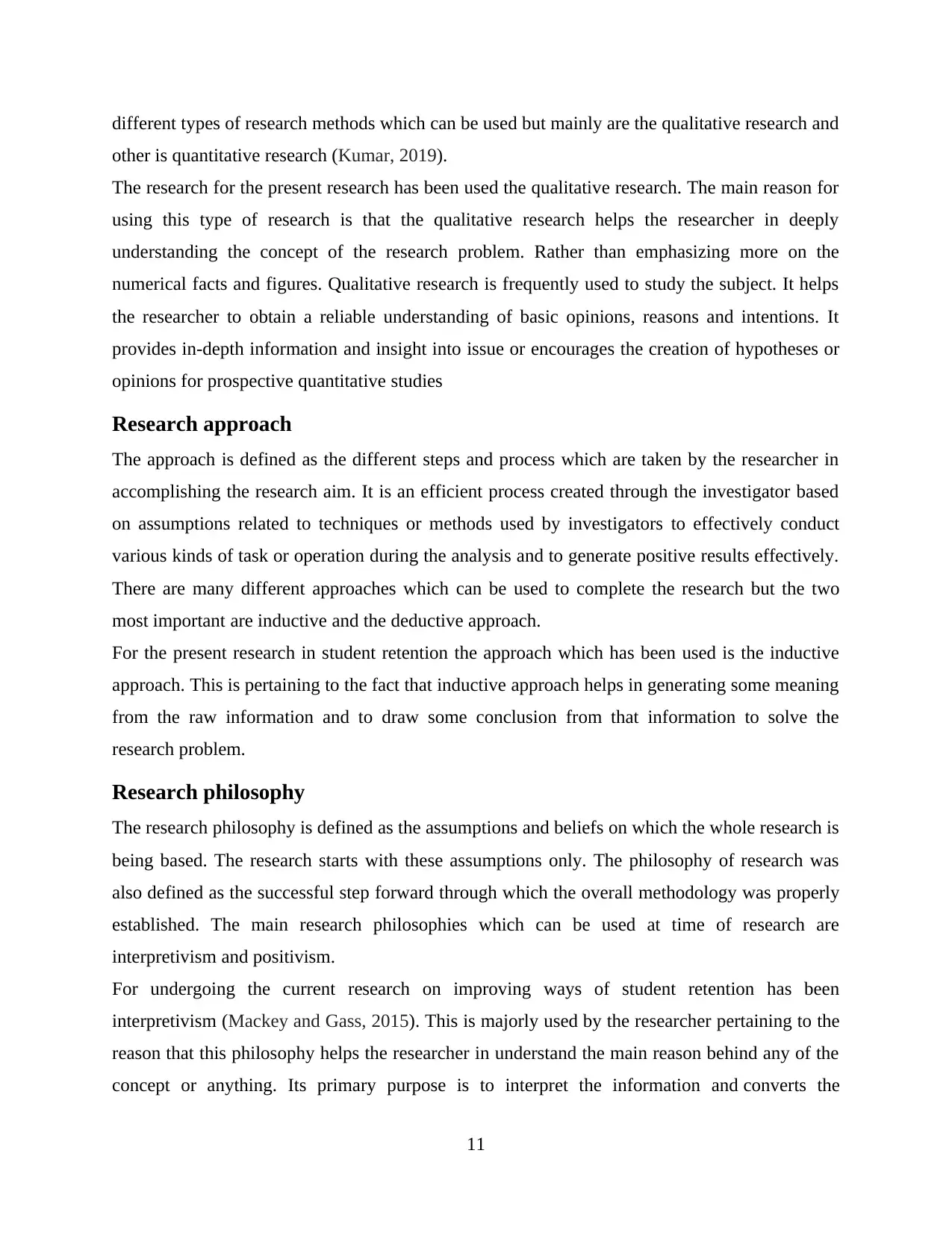
different types of research methods which can be used but mainly are the qualitative research and
other is quantitative research (Kumar, 2019).
The research for the present research has been used the qualitative research. The main reason for
using this type of research is that the qualitative research helps the researcher in deeply
understanding the concept of the research problem. Rather than emphasizing more on the
numerical facts and figures. Qualitative research is frequently used to study the subject. It helps
the researcher to obtain a reliable understanding of basic opinions, reasons and intentions. It
provides in-depth information and insight into issue or encourages the creation of hypotheses or
opinions for prospective quantitative studies
Research approach
The approach is defined as the different steps and process which are taken by the researcher in
accomplishing the research aim. It is an efficient process created through the investigator based
on assumptions related to techniques or methods used by investigators to effectively conduct
various kinds of task or operation during the analysis and to generate positive results effectively.
There are many different approaches which can be used to complete the research but the two
most important are inductive and the deductive approach.
For the present research in student retention the approach which has been used is the inductive
approach. This is pertaining to the fact that inductive approach helps in generating some meaning
from the raw information and to draw some conclusion from that information to solve the
research problem.
Research philosophy
The research philosophy is defined as the assumptions and beliefs on which the whole research is
being based. The research starts with these assumptions only. The philosophy of research was
also defined as the successful step forward through which the overall methodology was properly
established. The main research philosophies which can be used at time of research are
interpretivism and positivism.
For undergoing the current research on improving ways of student retention has been
interpretivism (Mackey and Gass, 2015). This is majorly used by the researcher pertaining to the
reason that this philosophy helps the researcher in understand the main reason behind any of the
concept or anything. Its primary purpose is to interpret the information and converts the
11
other is quantitative research (Kumar, 2019).
The research for the present research has been used the qualitative research. The main reason for
using this type of research is that the qualitative research helps the researcher in deeply
understanding the concept of the research problem. Rather than emphasizing more on the
numerical facts and figures. Qualitative research is frequently used to study the subject. It helps
the researcher to obtain a reliable understanding of basic opinions, reasons and intentions. It
provides in-depth information and insight into issue or encourages the creation of hypotheses or
opinions for prospective quantitative studies
Research approach
The approach is defined as the different steps and process which are taken by the researcher in
accomplishing the research aim. It is an efficient process created through the investigator based
on assumptions related to techniques or methods used by investigators to effectively conduct
various kinds of task or operation during the analysis and to generate positive results effectively.
There are many different approaches which can be used to complete the research but the two
most important are inductive and the deductive approach.
For the present research in student retention the approach which has been used is the inductive
approach. This is pertaining to the fact that inductive approach helps in generating some meaning
from the raw information and to draw some conclusion from that information to solve the
research problem.
Research philosophy
The research philosophy is defined as the assumptions and beliefs on which the whole research is
being based. The research starts with these assumptions only. The philosophy of research was
also defined as the successful step forward through which the overall methodology was properly
established. The main research philosophies which can be used at time of research are
interpretivism and positivism.
For undergoing the current research on improving ways of student retention has been
interpretivism (Mackey and Gass, 2015). This is majorly used by the researcher pertaining to the
reason that this philosophy helps the researcher in understand the main reason behind any of the
concept or anything. Its primary purpose is to interpret the information and converts the
11
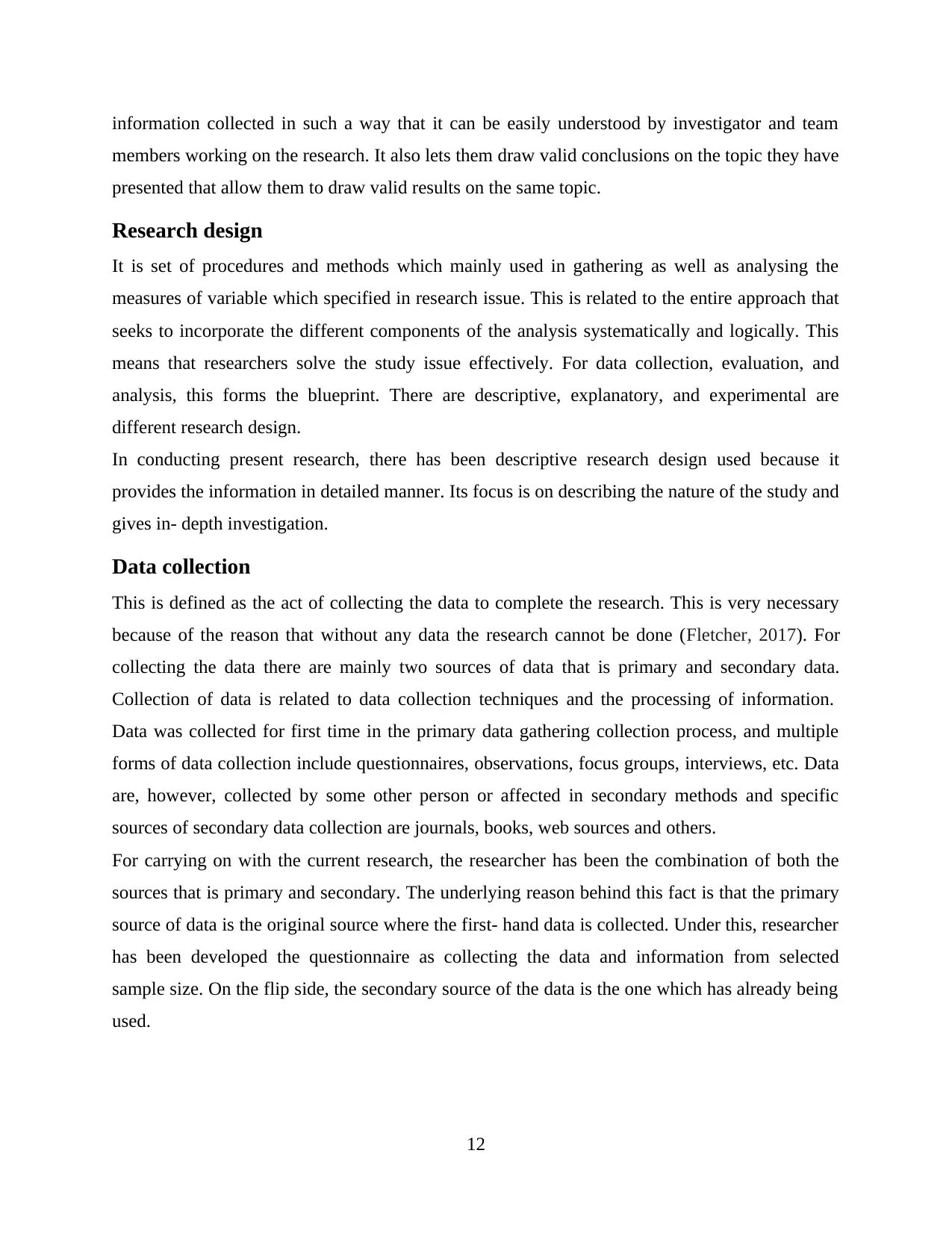
information collected in such a way that it can be easily understood by investigator and team
members working on the research. It also lets them draw valid conclusions on the topic they have
presented that allow them to draw valid results on the same topic.
Research design
It is set of procedures and methods which mainly used in gathering as well as analysing the
measures of variable which specified in research issue. This is related to the entire approach that
seeks to incorporate the different components of the analysis systematically and logically. This
means that researchers solve the study issue effectively. For data collection, evaluation, and
analysis, this forms the blueprint. There are descriptive, explanatory, and experimental are
different research design.
In conducting present research, there has been descriptive research design used because it
provides the information in detailed manner. Its focus is on describing the nature of the study and
gives in- depth investigation.
Data collection
This is defined as the act of collecting the data to complete the research. This is very necessary
because of the reason that without any data the research cannot be done (Fletcher, 2017). For
collecting the data there are mainly two sources of data that is primary and secondary data.
Collection of data is related to data collection techniques and the processing of information.
Data was collected for first time in the primary data gathering collection process, and multiple
forms of data collection include questionnaires, observations, focus groups, interviews, etc. Data
are, however, collected by some other person or affected in secondary methods and specific
sources of secondary data collection are journals, books, web sources and others.
For carrying on with the current research, the researcher has been the combination of both the
sources that is primary and secondary. The underlying reason behind this fact is that the primary
source of data is the original source where the first- hand data is collected. Under this, researcher
has been developed the questionnaire as collecting the data and information from selected
sample size. On the flip side, the secondary source of the data is the one which has already being
used.
12
members working on the research. It also lets them draw valid conclusions on the topic they have
presented that allow them to draw valid results on the same topic.
Research design
It is set of procedures and methods which mainly used in gathering as well as analysing the
measures of variable which specified in research issue. This is related to the entire approach that
seeks to incorporate the different components of the analysis systematically and logically. This
means that researchers solve the study issue effectively. For data collection, evaluation, and
analysis, this forms the blueprint. There are descriptive, explanatory, and experimental are
different research design.
In conducting present research, there has been descriptive research design used because it
provides the information in detailed manner. Its focus is on describing the nature of the study and
gives in- depth investigation.
Data collection
This is defined as the act of collecting the data to complete the research. This is very necessary
because of the reason that without any data the research cannot be done (Fletcher, 2017). For
collecting the data there are mainly two sources of data that is primary and secondary data.
Collection of data is related to data collection techniques and the processing of information.
Data was collected for first time in the primary data gathering collection process, and multiple
forms of data collection include questionnaires, observations, focus groups, interviews, etc. Data
are, however, collected by some other person or affected in secondary methods and specific
sources of secondary data collection are journals, books, web sources and others.
For carrying on with the current research, the researcher has been the combination of both the
sources that is primary and secondary. The underlying reason behind this fact is that the primary
source of data is the original source where the first- hand data is collected. Under this, researcher
has been developed the questionnaire as collecting the data and information from selected
sample size. On the flip side, the secondary source of the data is the one which has already being
used.
12
⊘ This is a preview!⊘
Do you want full access?
Subscribe today to unlock all pages.

Trusted by 1+ million students worldwide
1 out of 37
Related Documents
Your All-in-One AI-Powered Toolkit for Academic Success.
+13062052269
info@desklib.com
Available 24*7 on WhatsApp / Email
![[object Object]](/_next/static/media/star-bottom.7253800d.svg)
Unlock your academic potential
Copyright © 2020–2025 A2Z Services. All Rights Reserved. Developed and managed by ZUCOL.





